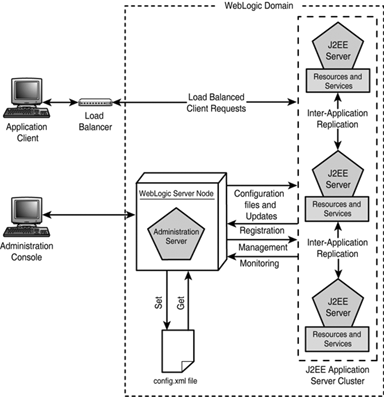Understanding WebLogic Clusters
| In general terms, a WebLogic cluster is a group (two or more) of WebLogic Server instances (managed servers) that have been configured to share their resources, and through coordinated load balancing and replication mechanisms, the WebLogic cluster provides a very highly available and scalable execution environment for deployed J2EE Web and enterprise applications. An application deployed homogeneously to every server instance in a WebLogic cluster appears as a single instance of the application to a client, regardless whether the client is Web or Java based. As illustrated in Figure 25.3, the administration server is responsible for configuring, managing, and monitoring all WebLogic Server instances (nonclustered and clustered) and resources in that domain. Because the administration server contains the configuration information for a WebLogic cluster, it must be available for connection to enable the clustered server instances to start up. When the clustered server instances are running, the availability of the administration server has no effect on the load-balancing and failover capabilities of the cluster. In a production environment, the administration server should not be configured as part of a WebLogic cluster because it must always be available for monitoring all other WebLogic instances and hence should not be overloaded with client requests . Figure 25.3. A WebLogic environment consisting of clustered WebLogic Server instances. From an administration perspective, each WebLogic cluster is managed as a single logical entity in the domain. For this reason, all WebLogic Server instances that constitute a cluster must reside in the same domain. Clusters cannot span across WebLogic domains. Understanding Which Objects Can Be ClusteredFor a clustering solution to be realized for both J2EE Web and enterprise applications, the WebLogic cluster provides scalability (via load balancing) and high-availability (via failover mechanisms) support for the following J2EE objects:
Note File and Time services can be used within a cluster but cannot take advantage of any load-balancing or failover mechanisms. The mechanisms the WebLogic cluster implements to ensure failover and load balancing for these objects vary in their implementation and are discussed in their respective sections later in this chapter. Examining Deployment Restrictions to the WebLogic ClusterThe deployment restrictions differ between WebLogic Server 7 and WebLogic Server 7 SP1 (Service Pack 1) as follows :
|
EAN: 2147483647
Pages: 360
